According to a survey by Marketo, 43% of respondents revealed that lead scoring was the top challenge faced by them. Wondering what lead scoring is? Well, lead scoring is a feature that allows you to recognize a prospect who matches the profile of your target customer and ascertain his or her interest level in your products or services. Based on this information, you can deliver more relevant content that would bring better engagement. In other words, it is a combined sales and marketing tactic to rank leads and determine their sales-readiness.
The process of lead scoring starts with assigning points on the basis of user behavior and then implementing rankings of A, B, C, D, or tagging them as hot, warm, or cold leads. For example: If a lead has downloaded your rate card, you can consider it as a hot lead who is more inclined to buy from you.
According to the details obtained through lead scoring, marketers can either fast-track the prospects to sales or nurture them with drip marketing campaigns.
Common Lead Scoring Variables
Generally, companies can bifurcate the lead scoring variables into three broad types, namely:
- Demographic and firmographic parameters
- Behavioral scoring by measuring clicks, keywords searched for, and website visits
- Engagement on email and social media
- Predictive scoring that reflects the likelihood of making a purchase.
Considering these aspects as the foundation of lead scoring, you can filter out prospective clients who do not meet your target customer profile and focus on the ones who do.

Now, the question arises that what type of scoring model would match your business. This depends on a number of factors.
Let’s discuss all these points one by one.
1. Define the objective of building the lead scoring model.
First of all, whenever you think of employing the lead scoring model for your business, determine its goal and the information you would want from the prospective customer.
Ask yourself:
- Do you want to bridge the gap between the marketing and sales department?
- Are you looking forward to measuring the engagement of the Marketing Database?
- Do you want to know the product or service that is bringing you the maximum engagement and revenue?
- Will it help you to figure out which marketing channel is the most popular among your customers?
The answers to these questions will define the objective of your lead scoring model. On the basis of this information, you can move on to the next step.
2. Shortlist the issues that you will be able to overcome with the help of the scoring model.
Most of the time, there is a huge communication gap between Marketing and Sales professionals. The sales department is not completely aware of the prospect’s past interaction with the brand or their sales-readiness. Besides, the marketing professionals and sales executives might not be clear about the actual engagement with the brand. Many companies hold regular conferences, live events, and webinars in addition to conventional marketing initiatives like email, social media, and direct mail. Despite all these efforts, they are not able to ascertain the effectiveness of these platforms or invest in the right channel.
Marketo’s scoring model will allow you to match your brand personality with your audience and the right channel to bring the best results.
3. Start creating your scoring model wireframe
Once you have defined the objective of your scoring model and the challenges you wish to overcome, you can proceed to the creation of the scoring model.
Steps to build the scoring model
a. Establish the number of fields you will need in your scoring model
According to the industry of your business and its needs, you must decide the number of fields. Subsequently, go to Admin> Field Management> Create New Custom Field with Type = Score for each field.
b. The second step is to work out the behavioral activities that you want to score.
Determine the value for every activity along with inactivity. Prioritize each activity based on your business operations and then choose the values.
Go to My Tokens in your Scoring Program and then, assign a Score token for every activity that you would want to track and measure.
c. In the third step, add a smart campaign. Smart list represents the activity to be scored and flow step is the change in the Score Value.
d. Lastly, you must determine the demographic information you want to score and the value for every parameter.
Just like you did in Step 2, go to My Tokens in the Scoring Program and assign a score token for every demographic value you want to measure.
To wrap up, I would like to share an example of a scoring program, where every activity has a corresponding positive and negative value. For instance: If someone attends your webinar, the prospect will be scored at +5 and if not, -5.
If this leaves you intrigued and scratching your head, just get in touch with Marketo experts at Uplers and we would love to help you out.






Disha Bhatt (Dave)
Latest posts by Disha Bhatt (Dave) (see all)
5 Tips To Extract Amazing Long-term Results with Salesforce Marketing Cloud & Email Marketing
What is the Right Email List Size and How to Grow Your List for Effective Marketing